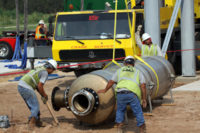Manufacturing Success
Briggs & Stratton Corp., Milwaukee, is a Better Buildings Challenge partner that has 10 facilities, including seven manufacturing plants that total 5.8 million sq ft. The company has committed to reduce, by 2018, its energy intensity by 25%, against a 2007 baseline, and has achieved, to date, 20% reduction under the program.
Steve Hinkens, Briggs & Stratton's corporate energy services manager, says the company's progress is linked to implementing best practices, with DOE assistance. "Lighting is the first thing people think about [in improving EE]," he says. The company has harvested this low-hanging fruit by replacing its plants' high-intensity-discharge lights—large, domelike lights consuming 400 to 1,000 watts per fixture—with fluorescent fixtures that use half the energy.
Three of Briggs' plants melt aluminum in gas-fueled furnaces to create castings, Hinkens says. Improved efficiencies have come from adjusting the furnaces—resetting dampers, for example—and installing variable-frequency drives on motors for HVAC equipment and process water.
The company joined the program to take advantage of the audits DOE does for specific processes, including steam, compressed air, fans and motors, and process heating and pumps, Hinkens says. DOE performs audits to identify needs, then conducts training in best practices for plant personnel.
Both Sides Now
Johnson Controls Inc. (JCI) operates on both sides of the EE market: The company is a partner in the Better Building Initiative, and it provides energy services to its customers. JCI's goal in the DOE program is to reduce, by 2020, energy intensity by 25%, against a 2009 baseline, in its 69 facilities, which include 60 manufacturing plants, encompassing about 16 million sq ft of floor space.
As an energy-services company, JCI operates in various capacities. Depending on a customer's needs, the firm can provide energy-services consulting, co- ordinate consultants and contractors for EE projects, and perform the work and supply the equipment and technology.
Brandon Jackson, VP of construction sales, describes how the company helped a customer that was planning an expansion and realized it was spending too much on energy. JCI helped identify needs and best EE practices. For the expansion, the consultant recommended upgrading chillers with variable-speed drives and installing a building management system to automate energy controls and optimization technology to coordinate the operation of the entire system.
"From the boardroom to the boiler room, building technologies are expected to drive outcomes that consume less and achieve more," Jackson says.




